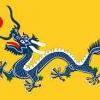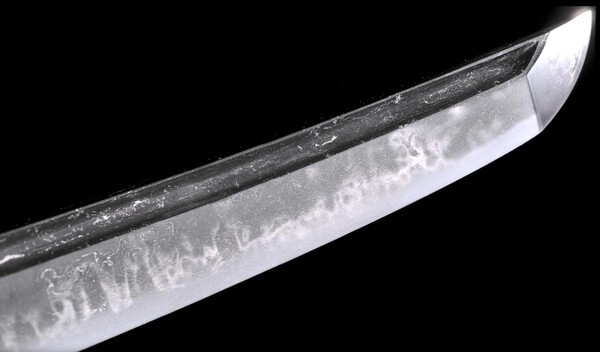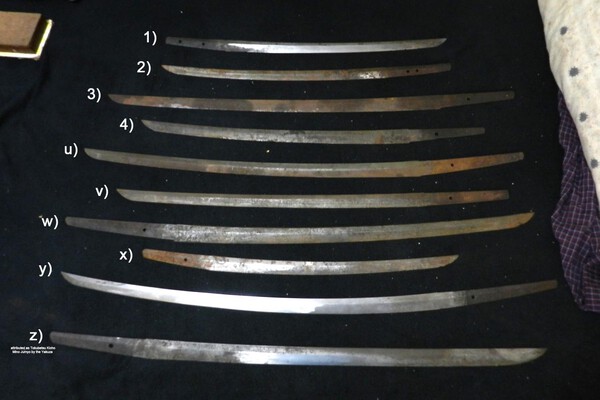
Caleb Mok
Members-
Posts
95 -
Joined
-
Last visited
-
Days Won
2
Caleb Mok last won the day on November 19 2015
Caleb Mok had the most liked content!
About Caleb Mok
- Birthday 06/07/1984
Profile Information
-
Gender
Male
-
Location:
Hong Kong
-
Interests
Stacking paper
Profile Fields
-
Name
Caleb M
Recent Profile Visitors
The recent visitors block is disabled and is not being shown to other users.
Caleb Mok's Achievements
-
Ebay NTHK Akihiro Katana for $9700 USD?
Caleb Mok replied to Caleb Mok's topic in Auctions and Online Sales or Sellers
Oh duh, the era. Many thanks again. -
Ebay NTHK Akihiro Katana for $9700 USD?
Caleb Mok replied to Caleb Mok's topic in Auctions and Online Sales or Sellers
Many thanks for your very educating reply. If i may ask for my learning...the part in the kanteisho that says 相州鎌倉 秋広...THAT is the giveaway that it's not papered to him isn't it? If so, what should it say instead? (not questioning your knowledge at all, just want to learn how to read kanteisho's...i couldn't make useful the website that breaks them down to their components). Or simply, in a as non-challenging way is possible, may I ask you, how is one supposed to know in this situation. Many thanks. (also, how can it be during 鎌倉/kamakura? Akihiro worked in Nambokucho, right?) -
For those who'd rather see the parts under focus all at once as opposed to in 15 seconds. Distorted version; Source - www.youtube.com/watch?v=lv8HeC2vnq0 (1:52-2:07) ... For the original 3150 x 1850 pixels versiobn...if anyone wants it...can someone help me post it up somewhere? Thanks -Caleb
-
Sorry I tried to search using various ways, sources and languages but couldn't find the answer. As the title denotes, what is the area between the hasaki and the shinogi called? Or, what is ha+ji called? Thanks
-
If you happened to have purchased, rather than inherit, this sword, then there's a strong chance it is worthless ie has fatal flaw(s). My experience, confirmed by some Japanese sources, say that nowadays any sword found to have fatal flaws would be deliberately covered in rust and put into circulation. I apologize that i don't have better news - Caleb
-
Number 3 is a Shinshinto of nagasa 27-3/8" or 69.4cm, signed Eshu-ju Tomikuni (ubu tang). Shortest tang i've seen but i haven't seen many -Caleb
-
Grey, I totally agree with you, but i'm curious about the funbari, both in the hasaki and the mune. I suppose that people who convert broken pieces of swords into "ko-wakizashi" are smart enough to fake funbari into them to? Ryan, sorry i'm totally ignorant of US geography and climate, but here in Hong Kong if you don't oil your sword it WILL RUST. I strongly recommend this regiment: 1) wipe the blade with mineral oil and either facial tissue or 3-ply or more toilet paper 2) wait one week 3) wipe again: -If there's any orange at all, even the slightest, this means that during this period of the year you need to wipe it every week -if not, go to 4) 4) wait 2 weeks 5) repeat 2), only if there's no orange at all, wait a month this time 6) repeat bi-monthly, quarterly, etc... until you determine how often your blade actually rusts in your region. ***THE GOOD NEWS IS*** in fifty years (lol) if your level of humidity is like that of Japan, your sword will get darker and might enhance the hamon, that is, the ji will patinate and darken more than the ha. This is basically controlled rusting, and is the working principle of the classic (not modern) sashikomi styled polishing which "takes 50 years to look best". If your climate is like that in Vancouver where my stuff basically never rusted....it'll take ~longer~ My point is, there IS something you can do. You might not even need the shirasaya. The beauty of national treasure blades, after all, is uncovered by shirasaya for extended periods. If you take time to frequently look at this object, (and keep it rust-free) it may add to its value more effectively than a shirasaya
-
Sharpening Instead Of Polishing
Caleb Mok replied to Prewar70's topic in General Nihonto Related Discussion
(no knowledge of historical practices below if that's all you're looking for) Swords, which were hardened to below ~60 Rockwells, in some way made up for their inability to get as "sharp" as blades hardened harder by the fact that they reached much higher velocities. As for the degree of the edge's bevel, we do know that generally speaking, the lower the angle, the sharper. But the discussion brought up sharpness testing in addition to the general way of ~sharpening for sharpening sake~, and this i think will give a different way of looking at bevel angle, as well as other factors. I submit my humble observation that when woodworking i'm interested at tools' ~overall~ sharpness between sharpenings, not just its initial, right-off-the-stones, sharpness. The initial sharpness is meaningless to me in this: It quickly goes away and i am stuck with a "sharpness" that only dwindles, and depending on that bevel angle, the RC and composition of the blade, and the finish, it can dwindle at vastly different rates. The "sharp" tool for me then is a contest between "the edge that gets real sharp but loses it quickly" and the so-called "the edge that doesn't get sharp and you're stuck with it a long time." Well, ~how~ sharp? ~How~ long? The winner is the one with the better average score. So bevel angle alone is not meaningful to me. A white-steel blade that is very high in RC is a PAIN to sharpen and to increase the surface area that i need to sharpen by decreasing its bevel angle is too much work for me: for such a blade i'd prefer going higher grits to make up for its lack of an acute angle. The opposite can apply to a soft blade. With sword testing it was probably done with right-off-the-stones, initial sharpness. It would make every sense that way. Now let's consider the scenario that magnifies every factor EXCEPT the blade's RC: the cutting of very easily-cut things, like vegetables. Here, a well polished and strongly acute bronze razor might do as well as a 67 RC highly-ceramic steel (i do not call them "highly-alloyed", but "highly ceramic", for that is what they are). Now let's consider the scenario that magnifies ONLY the blade's RC: hand-scraping a hand-made saw's blank down to correct thickness. Here, a highly polished blade might do as well as one not so highly polished AS LONG AS it is made of a high RC blade. Now let's go back to sword testing. It was on bodies, of flesh and bone. Knowing that you CANNOT alter the RC, what are the only variables left? The velocity of the blade, its finish, and the bevel angle. I do not know about you, but i find that in sharpening my kitchen knives to cut stacks of 3"-4" pork chop stacks in one stroke, sharpening anywhere finer than Shapton Pro 2K becomes diminishing returns in terms of initial sharpness (Shapton 2K is finer than some brand's higher stated grits). 5K and higher is VASTLY superior in terms of sharpness retention* for me...but that's not what we're talking about here. We're talking about one stroke, how many bodies; not many strokes, how many bodies. As for cutting bone with a deba(yes, actually cutting, not crushing...even though in dispatching an opponent you need neither), i find that you can do whatever you want but as long as you push-cut you will certainly fail and if you draw-cut you are more likely to succeed--the more slanted the better. Which implies a sword with more sori will carve through bone better. Well there you have it: if you want a practical sword for mass-infantry tactics, you'll go with with a straight sword; if you want wonderful cut-testing results, go for the most impractically heavy sword you have and hope it's highly curved too. You don't have to polish the blade that much: because if you swing it THAT HARD and it hits flesh, a finish equivalent to 2K or 12K wouldn't really be that different ON THE FIRST STRIKE; if you hit metal armor, it wouldn't cut regardless. But if your sword is to hit things again, and again, and again, then...i'll be honest i have no idea but i'm biased to think the RC is the most important factor (even though i'm trying to exclude this factor here) but that's because i cut wood much more than food or my face. Someone who cuts the latter, on the other hand, i'd imagine, if he/she is biased, would be biased towards higher grit. So my speculation would be, because it is PAINFULLY long to grind hardened steel with natural Binsui (either the modern white type with lots of impurities or the more rare yellow type with few impurities) or Arato, as opposed to aluminum oxide, the sword that had an acute angle, if needed to be sharpened quickly, would face the pressure to be converted into a blunt angle...and that sword will forever have lost its "maximum" sharpness until there's times of less war when it might be restored to a "correct" angle whatever it is (i have never read literature on this...only literature on niku...but niku can be changed). The harder swords would be subject to a greater incentive to blunt their edges' angles; the softer swords would be subject to less. Though it's impossible to speculate what angles koto, or any heavily-polished sword, may have had, we do have many Shinto-and-post swords that we can see have a rather blunt angle (well, from my experience anyway) and many sources say that polishers say Shinto steel is harder. Again, without aluminum oxide, acute angles can take a really long time... And as for the finish ie how high the grits go for use...probably not that high, which literature seem to agree on. I remember somewhere they said they probably stopped at chu-nagura...but such a statement imho is meaningless. I was told by a reputable source that kaisei is only slightly finer than binsui, but binsui is a HUGE family of stones of varying finenesses and hardnesses that share members with the amakusa. Chu nagura, on the other hand, are usually not-hard. (just look at it, obviously very sedimentary at some point before becoming metamorphic). The hardness and coarseness of the binsui/kaisei if urgency called for them would have made a very deep impression to the blade that the chu-nagura would take forever to erase. Sorry i digress: just trying to say, i don't think we'll ever really know because it'd have depended on many varying cases of'urgency and they had a vast array of stones, and maybe even bevel angles if the steel was soft enough, to choose from to accommodate. Lastly, from experience, it is impossible for me to match the sharpness of something sharpened parallel to the edge to that sharpened perpendicular or 45 degrees to it. Yet we see consistent info regarding the 45 degrees to traditional Japanese chef knifes, but not Nihonto. Goes to show that maybe, just maybe, they understood that apart from cutting tests, it didn't actually matter ~that~ much. Now the artistic quality on the other hand, that's an entirely different story! -Caleb *I can elaborate on this but pls pm me... this has nothing to do with historic Japanese swords -
I made a decision not to post on this forum not on a whim but on a principle...but upon seeing how a fellow Canadian basically getting ripped off, i can't help but offer unsolicited points of observation. Daisho are imho hard to sell. Why do we often see fittings and sword sold separately? Because it is rare enough that A ) someone will go all out for the sword or B ) someone will go all out for the fittings...but MUCH rarer still is that someone will go all out for BOTH the sword and the fittings. This package has imho SO MUCH going for it, in ONE package: 1) good and characteristic workmanship that even a noob like me can say, "Ah yes i saw something like this on a different Jumyo before" 2) a real daisho 3) a good (but not flawless) polish 4) signed too for goodness sake Now, time for me to rant. What we ~like~ to believe is that sword features like diamond carats, go up exponentially ie a 2-carat diamond costs a lot more than two 1-carat diamonds...but this is sold like the price of a signed random daito plus a random signed shoto added together, and still no one went for it (oh but people are going for stuff of Ebay!). Perhaps it is because the daito is not quite long enough, or the mei was signed a little bit off, or that it has no papers etc etc. But aren't we suppose to collect on artistic merit, and, in this case, historical significance/rarity because of the daisho, not on how long something is or how it was signed? (sigh) Sorry, just wanted to rant. I can't buy this, i made a commitment to stop. But i really do hope Travis/Mr. Clarke (however you like to be addressed by a 30-something person) can someone survive his financial strain to not sell it at this price. There's two ways to put this i think: either 1) whoever thinks it's worth less than $2,395 USD does not know what they're getting and is less deserving to get it than someone who does, or 2) Price for sold crap on Ebay is rising...don't know about mid-tier stuff like this but either way the longer you wait the better -Caleb
-
Caleb Mok started following The 2016 Nbsk (7Th) Japanese Sword Craftsmens' Competition
-
1) Do you get the work back when the competition is over? 2) Is the exhibition of winning pieces at Sakaki-Machi Museum of Tetsu in Nagano prefecture accessible to general public and if so, when? 3) Is there any chance of meeting and conversing with craftsman and/or other enthusiasts there? 4) In your opinion, if i intend to save money to go there in 2017 just to meet craftsman, and If I don't have much experience conversing in Japanese, can a JLPT N2 suffice? Or do i have to go beyond N1 ie be super-fluent before I should attempt this venture? Many thanks, Caleb
-
I'm putting my $ it's curly hair...if it is a 2, it's a perfect two which means it's machine stamped/marked. But why machine stamp/mark a 2 that actually doesn't look like a standard two ie the curve appears bigger than the base and is really, really circular for a 2. I don't know, i don't know... My thoughts on what's here is...because I am a noob, i am very susceptible to being unable to distinguish Koto from good Shinshinto. In my noobish opinion it doesn't look shinto. So i'm looking hard for any signs by which to automatically write it off as either...which i'm failing to find. Per majority here (?) I'd recommend polish by traditionally trained polisher, and if getting a non-Master grade polish (master grades are like $3000-$4000 USD for katana instead of the "usual" 120000 yen...right?) don't expect exemplary results EVEN IF the sword itself is exemplary. But, difficult to recoup the cost even if Koto simply because it's mumei wak. If Shinshinto, extremely difficult to justify the investment, even if a non-master grade polish. But totally enjoyable as-is: i can totally see myself enjoying the weekly/monthly/quarterly/etc wipe with oil and cotton balls and relish seeing the ball get orange and know the nugui is improving with this sword. In the same way a traditional sashikomi takes 50 years to look its best, the sword may look better in years to come--if taken care of correctly --Caleb
-
Wasn't it pine sap or something like that? Namikawa Heibei used to (and still does?) sell pine resin or something like that for gluing things...for some reason i am either confusing it with something else or maybe they really did use pine resin. A very sticky and cheap (compared to urushi) glue quite suitable for gluing tsukamaki. I'm personally okay with supergluing it because, if it's for me, i don't value my own work very much anyway, and if it's for my clients (which i haven't had for many years now), i get the okay from them first. They usually get the hint that "i'm only useful to you cheap; it's only cheap if i use superglue" and if not i'd have to tell them politely EDIT: nevermind, it's true: http://www.namikawa-ltd.com/product/130 "300g. Used to glue or fix something. It will melt by adding heat. Tsukamaki-shi used to make Kusune (traditional glue) from Matsuyani and Natane oil. It prevents the Tsukaito from slipping." Above quote leaves little room for interpretation...unless of course, one argues Namikawa Heibei cannot be given any weight as far as authoritativeness on Nihonto knowledge is concerned...which, i guess is ~doable~ but why would you...... -Caleb
-
But what about Rai Kuniyoshi, Emperor Gotaba, Yamato Amakuni (Kogarasu-maru), Yamato Amakumo, Yamato-no-Orochi (Amano Murakumono Tsurugi), and Susanoono Mikoto (Totsukano Tsurugi)? (sorry, couldn't resist. Feel free to delete if inappropriate...i see it coming and will not take offence)






